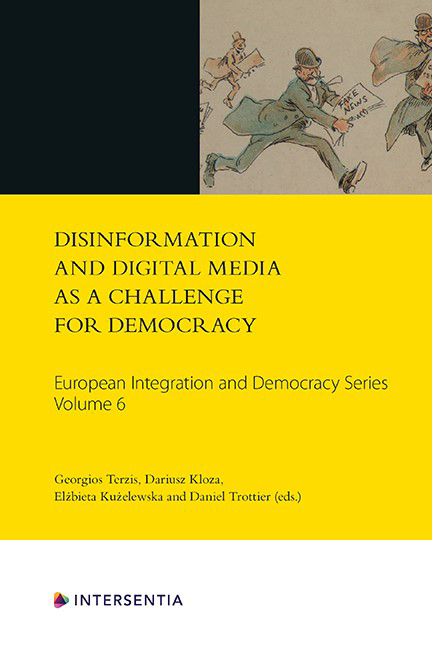Book contents
- Frontmatter
- Foreword: Fooling All of the People All of the Time: Democracy in the Age of Fake News
- Introduction: ‘They All Hear “Ping” at the Same Time’
- Contents
- List of Abbreviations
- List of Contributors
- PART I THEORETICAL APPROACHES TO AND THE CONCEPTUALISATION OF DISINFORMATION
- PART II EXPERIENCE OF DEALING WITH DISINFORMATION
- PART III SOLUTIONS TO DEAL WITH DISINFORMATION AND THEIR CRITIQUE
16 - Regulating Internet Content with Technology: Analysis of Policy Initiatives Relevant to Illegal Content and Disinformation Online in the European Union
Published online by Cambridge University Press: 26 May 2021
- Frontmatter
- Foreword: Fooling All of the People All of the Time: Democracy in the Age of Fake News
- Introduction: ‘They All Hear “Ping” at the Same Time’
- Contents
- List of Abbreviations
- List of Contributors
- PART I THEORETICAL APPROACHES TO AND THE CONCEPTUALISATION OF DISINFORMATION
- PART II EXPERIENCE OF DEALING WITH DISINFORMATION
- PART III SOLUTIONS TO DEAL WITH DISINFORMATION AND THEIR CRITIQUE
Summary
INTRODUCTION
Within the European Union (EU), online disinformation has been addressed from a variety of regulatory angles. Legislation and policy initiatives against defamation, incitement to hatred and violence, or banning certain misleading advertising techniques all seek to limit the spread of disinformation. Moreover, within the context of electoral campaigns, the problem can be tackled by regulating the spending and transparency of political campaigns, enforcing data protection rules and bolstering against cyberattacks. More broadly, institutional support is also provided to safeguard media pluralism, encourage fact-checking and enhance media literacy.
It is clear that disinformation has taken on new proportions in this age of social media. Within the EU, 2018 triggered a flurry of additional reflections and actions on online disinformation. Table 1 provides a timeline of disinformation policy-related initiatives at a European level from 2015 to the present day, ranging from cybersecurity and strategic communications to tackling illegal content and disinformation online. Social media platforms in particular have been in the spotlight in relation to curbing the spread of disinformation on their networks.
Use of technology has often been heralded as the silver bullet to deal with social problems online. Over time, technological solutions to detect and remove illegal/undesirable content have become more effective, but they also raise questions about who is the ‘judge’ in determining what is legal/illegal and desirable/undesirable in society. Underlying this use is a difficult choice between different elements of law and technology, public and private solutions, with trade-offs between judicial decision-making, scalability and the impact on users’ freedom of expression.
Importantly, EU initiatives beyond disinformation also call for proactive measures by online intermediaries to aid the removal of illegal content. The proposed EU Regulation on the Prevention of Dissemination of Terrorist Content Online targets rapid removal of terrorist content by online intermediaries. Article 17 of the 2019 Copyright in the Digital Single Market Directive obliges intermediaries to conclude license agreements with rightsholders, or in absence thereof, holds them liable for the availability of unauthorised copyrighted content. Without sufficient user safeguards, this will likely lead to broad filtering and over-blocking of content.
- Type
- Chapter
- Information
- Disinformation and Digital Media as a Challenge for Democracy , pp. 309 - 326Publisher: IntersentiaPrint publication year: 2020
- 1
- Cited by

